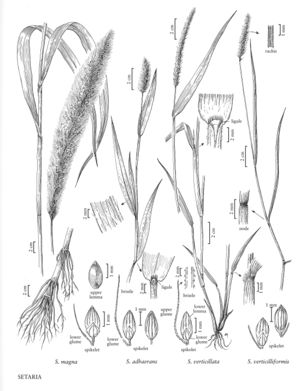Setaria verticilliformis
Plants annual. Culms 30-100 cm; nodes glabrous. Sheaths mostly glabrous, margins ciliate distally; ligules 1-2 mm, of hairs; blades 5-15 mm wide, flat, abaxial surfaces scabrous, adaxial surfaces sparsely villous. Panicles 5-15 cm, tapering to the apices, branches verticillate; rachises antrorsely rough hispid, without villous hairs; bristles solitary, 4-7 mm, antrorsely or retrorsely scabrous. Spikelets 2-2.3 mm. Lower glumes about 1/3 as long as the spikelets, obtuse, 1(3)-veined; upper glumes nearly as long as the spikelets; lower paleas about 1/2 as long as the spikelets, broad; upper lemmas finely and transversely rugose; upper paleas similar to the upper lemmas. 2n = 36.
Distribution
Md., N.J., Mo., Ala., Wis., D.C., N.Y., Pa.
Discussion
Setaria verticilliformis is a European adventive that has been found at scattered, mostly urban, locations in the United States.
Selected References
None.
